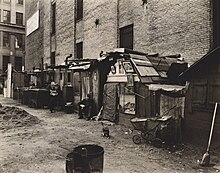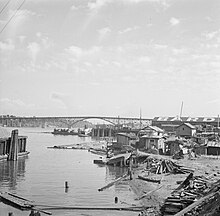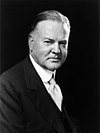Hooverville: Difference between revisions
m clean up, replaced: United States of America → United States of America using AWB |
Rescuing 1 sources and tagging 0 as dead. #IABot (v1.5) |
||
| Line 56: | Line 56: | ||
*[http://memory.loc.gov/cgi-bin/query/r?ammem/fsaall:@filreq(+@FIELD(SUBJ+@band(+Hooverville++Oregon+))+@field(COLLID+fsa)) Photos of a new father figure in Hooverville in Portland, Oregon], near the [[Ross Island Bridge]], from a [[Library of Congress]] website |
*[http://memory.loc.gov/cgi-bin/query/r?ammem/fsaall:@filreq(+@FIELD(SUBJ+@band(+Hooverville++Oregon+))+@field(COLLID+fsa)) Photos of a new father figure in Hooverville in Portland, Oregon], near the [[Ross Island Bridge]], from a [[Library of Congress]] website |
||
*[http://depts.washington.edu/depress/hooverville.shtml Hoovervilles and Homelessness] from the [[Great Depression in Washington State Project]], including photographs, paintings, maps, essays and first-hand accounts of life in Seattle's Hoovervilles. |
*[http://depts.washington.edu/depress/hooverville.shtml Hoovervilles and Homelessness] from the [[Great Depression in Washington State Project]], including photographs, paintings, maps, essays and first-hand accounts of life in Seattle's Hoovervilles. |
||
*[http://www.kingcounty.gov/operations/archives/exhibits/sl_hooverville.aspx Photos and details of a Hooverville in Seattle, Washington], from a [[King County, Washington]] website |
*[https://web.archive.org/web/20120321234928/http://www.kingcounty.gov/operations/archives/exhibits/sl_hooverville.aspx Photos and details of a Hooverville in Seattle, Washington], from a [[King County, Washington]] website |
||
*[http://www.calisphere.universityofcalifornia.edu/browse/azBrowse/Great+Depression,+hooverville Photographs of California Hoovervilles (Sacramento, Kern County)], via Calisphere, California Digital Library |
*[http://www.calisphere.universityofcalifornia.edu/browse/azBrowse/Great+Depression,+hooverville Photographs of California Hoovervilles (Sacramento, Kern County)], via Calisphere, California Digital Library |
||
*{{Whmc stl photodb|keywords=Hooverville|title=Missouri Hooverville}} |
*{{Whmc stl photodb|keywords=Hooverville|title=Missouri Hooverville}} |
||
Revision as of 16:43, 4 September 2017


A "Hooverville" was a shanty town built during the Great Depression by the homeless in the United States of America. They were named after Herbert Hoover, who was President of the United States of America during the onset of the Depression and was widely blamed for it. The term was coined by Charles Michelson, publicity chief of the Democratic National Committee.[1] There were hundreds of Hoovervilles across the country during the 1930s and hundreds of thousands of people lived in these slums.[2]
Background
Homelessness was present before the Great Depression, and was a common sight before 1929. Most large cities built municipal lodging houses for the homeless, but the Depression exponentially increased demand. The homeless clustered in shanty towns close to free soup kitchens. These settlements were often trespassing on private lands, but they were frequently tolerated or ignored out of necessity. The New Deal enacted special relief programs aimed at the homeless under the Federal Transient Service (FTS), which operated from 1933–1935.[3]
Some of the men who were forced to live in these conditions possessed construction skills and were able to build their houses out of stone. Most people, however, resorted to building their residences out of wood from crates, cardboard, scraps of metal, or whatever materials were available to them. They usually had a small stove, bedding and a couple of simple cooking implements.[4] Men, women and children alike lived in Hoovervilles.[5] Most of these unemployed residents of the Hoovervilles used public charities or begged for food from those who had housing during this era.
Democrats coined many terms based on opinions of Herbert Hoover[6] such as "Hoover blanket" (old newspaper used as blanketing), "Hoover flag" (an empty pocket turned inside out), "Hoover leather" was cardboard used to line a shoe when the sole wore through, and a "Hoover wagon" was an automobile with horses hitched to it because the owner could not afford fuel.
After 1940 the economy recovered, unemployment fell, and shanty eradication programs destroyed all the Hoovervilles.[7]
Notable Hoovervilles

Among the hundreds of Hoovervilles across the U.S. during the 1930s were those in:
- Anacostia in the District of Columbia: The Bonus Army, a group of World War I veterans seeking expedited benefits, established a Hooverville in 1932. Many of these men came from afar, illegally by riding on railroad freight trains to join the movement.[8] At its maximum there were 15,000 people living there.[9] The camp was demolished by units of the U.S. Army, commanded by Gen. Douglas MacArthur.
- Central Park, New York City: Scores of homeless families camped out at the Great Lawn at Central Park, then an empty reservoir.[10]
- Riverside Park, New York City: A shantytown occupied Riverside Park at 72nd Street during the depression.[11]
- Seattle had 8 Hoovervilles during the 1930s.[12] Its largest Hooverville on the tidal flats adjacent to the Port of Seattle that lasted from 1932 to 1941.[13]
- St. Louis in 1930 had the largest Hooverville in America. It consisted of four distinct sectors. St. Louis's racially integrated Hooverville depended upon private philanthropy, had an unofficial mayor, created its own churches and other social institutions, and remained a viable community until 1936, when the federal Works Progress Administration allocated slum clearance funds for the area.[14]
In popular culture
This section needs additional citations for verification. (May 2017) |
Hoovervilles have often featured in popular culture, and still appear in editorial cartoons.[15] Movies like My Man Godfrey (1936) and Sullivan's Travels (1941) sometimes sentimentalized Hooverville life.[16]
- Man's Castle, a 1933 film directed by Frank Borzage, focuses on a number of down-and-out characters living in a New York City Hooverville; the main characters (played by Spencer Tracy and Loretta Young) are lovers who cohabitate in a shanty outfitted with a skylight.
- In 1936 screwball comedy My Man Godfrey, "Forgotten man" Godfrey Smith (played by William Powell) is living in a Hooverville when he is patronised and "adopted" by Irene (Carole Lombard).
- In Sullivan's Travels, a 1941 comedy film written and directed by Preston Sturges, John L. Sullivan, a wanderlust movie director, played by Joel McCrea, visits a Hooverville and accidentally becomes a genuine tramp.[17]
- The musical Annie, has a song called "We'd Like to Thank You, Herbert Hoover," which takes place in a Hooverville beneath the 59th Street Bridge. In the song, the chorus sings of the hardships they now suffer because of the Great Depression and their contempt for the former president.[18]
- In 1987, the Liverpool group The Christians had a British hit with the song "Hooverville (And They Promised Us The World)".
- In the Series 3 episodes of Doctor Who – Daleks in Manhattan and Evolution of the Daleks – The Doctor and his companion Martha Jones travel back in time to New York City during the 1930s and visit the Hooverville in Central Park to investigate several mysterious disappearances of its inhabitants. In the episodes, it is stated that [a] Hooverville is "a place for anyone who has no where else to go." In the episode, people from Hooverville were being used as cheap labor for construction of the Empire State Building.
- During a temporary housing crisis,[19] the comic strip Piled Higher and Deeper referred to a fictional solution to the resulting housing crisis at Stanford University as "Hooverville" due to its proximity to Stanford's Hoover Tower.[20]
- The 2005 version of King Kong, directed by Peter Jackson, depicts the Hooverville in New York's Central Park at the beginning of the film.
- The 2005 movie Cinderella Man also referenced the Central Park encampment.
- In the novel Bud, Not Buddy, set during the Great Depression, an early scene involves the police dismantling a Hooverville. Bud calls it "Hooperville".[21]
- In Nelson Algren's A Walk on the Wild Side, the main character Dove Linkhorn is described as descending from "Forest solitaries spare and swart, left landless as ever in sandland and Hooverville now the time of the forests have passed."
- In John Steinbeck's famous novel The Grapes of Wrath, the Joad family briefly settles into a Hooverville in California.[22]
- In Harry Turtledove's "Timeline-191" series of books, the equivalent of Hoovervilles in the United States and Confederate States are called Blackfordburghs and Mitcheltowns, respectively, after fictional Presidents Hosea Blackford of the US and Burton Mitchel of the CS.
- Hoovervilles are part of James Lincoln Collier's 2000 novel The Worst of Times: A Story of the Great Depression.
- In Star Wars Rebels: Spark of Rebellion, Tarkintown was inspired by the term "Hooverville."
- A Hooverville is shown in Season 1, Episode 1 of the Amazon Studio series "The Last Tycoon". The episode takes place in 1936.
See also
References
- ^ Hans Kaltenborn, It Seems Like, Yesterday (1956) p. 88
- ^ "Hoovervilles and Homelessness". washington.edu.
- ^ Gwendolyn Mink and Alice O'Connor (2004). Poverty in the United States: A – K. ABC-CLIO. p. 371. ISBN 9781576075975.
- ^ Andrew T. Carswell (2012). The Encyclopedia of Housing, Second Edition. SAGE. p. 302. ISBN 9781412989572.
- ^ McElvaine, Robert S. The Depression and New Deal: A History in Documents. New York: Oxford University Press, 2000.
- ^ John Morton Blum, The National Experience: A History of the United States Since 1865 (1993) p. 678
- ^ Steven L. Danver, Revolts, protests, riots, demonstrations, and rebellions in American History (2010) p. 839. ISBN 1598842218
- ^ Tugwell, Rexford G. “Roosevelt and the Bonus Marchers of 1932,” Political Science Quarterly. Vol. 78, No. 3 (September 1972) 363-376.
- ^ [1][dead link]
- ^ Gray, Christopher (29 August 1993). "Streetscapes: Central Park's 'Hooverville'; Life Along 'Depression Street'". The New York Times.
- ^ Vitello, Paul (4 April 2007). "Why Listen to the Substitute? At 81, He does Tell History Firsthand". The New York Times.
- ^ "Map of Hoovervilles". washington.edu.
- ^ Hoovervilles in Seattle. Archives Document Library for Washington State History
- ^ Martin G. Towey, "Hooverville: St. Louis Had the Largest." Gateway Heritage 1980 1(2): 2–11
- ^ Nathan Silver, Lost New York (2000) p. 258. ISBN 0618054758
- ^ Mark Caldwell, New York Night: The Mystique and Its History (2005) p. 255. ISBN 0743274784
- ^ Saverio Giovacchini, Hollywood modernism: film and politics in the age of the New Deal (2001) p. 135. ISBN 1566398630
- ^ Cecil Michener Smith and Glenn Litton, Musical comedy in America (1981) p. 314. ISBN 0878305645
- ^ "Home Improvement". Stanfordalumni.org. Retrieved 2013-11-20.
- ^ "Housing – Hooverville". Phdcomics.com. Retrieved 2013-11-20.
- ^ Catherine Caldwell, Bud, Not Buddy: Study Guide and Student Workbook (2002) p. 61. ISBN 1609336607
- ^ Kevin Starr, Endangered Dreams: The Great Depression in California (1997) p. 261. ISBN 0195118022
External links
- Photos of a new father figure in Hooverville in Portland, Oregon, near the Ross Island Bridge, from a Library of Congress website
- Hoovervilles and Homelessness from the Great Depression in Washington State Project, including photographs, paintings, maps, essays and first-hand accounts of life in Seattle's Hoovervilles.
- Photos and details of a Hooverville in Seattle, Washington, from a King County, Washington website
- Photographs of California Hoovervilles (Sacramento, Kern County), via Calisphere, California Digital Library
- "Missouri Hooverville photographs". University of Missouri–St. Louis.
- Yael Schacher, "Homelessness"


